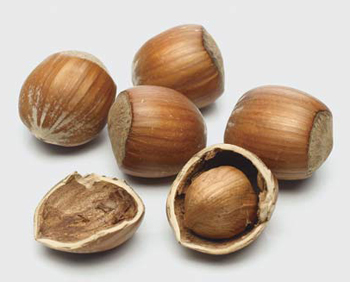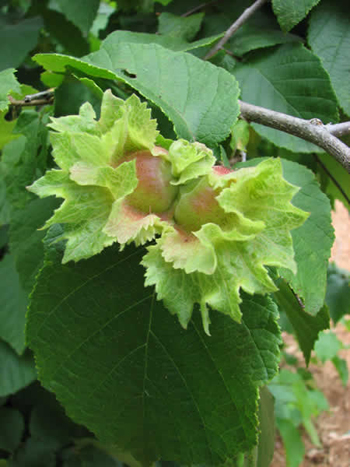Contents:
Common Names | Parts Usually Used | Plant(s) & Culture | Where Found | Medicinal Properties | Biochemical Information
Legends, Myths and Stories | Uses | Bibliography
Scientific Names

- Corylus americana
- Corylaceae
- Birch family
Common Names
- American hazelnut
- Hazel
- Hazel bush
- Hazelnut
Parts Usually Used
Inner bark and twig hairs
Back to Top
Description of Plant(s) and Culture

American hazelnut is a shrub that grows to 10 feet tall; the stems and leafstalks have stiff hairs. The leaves are heart-shaped, double-toothed, growing to 5 inches long. The plant flowers in April to May. The fruits are edible nuts encased in beaked, toothed bracts.
Back to Top
Where Found
Found in thickets from Maine to Georgia; Missouri, Oklahoma to Canada.
Back to Top
Medicinal Properties
Febrifuge, astringent
Back to Top
Biochemical Information
Magnesium, sulfur
Back to Top
Legends, Myths and Stories
According to the old-timers, eating too many hazelnuts can cause gas, stomach ache, and headache. They claimed if a snake was struck with a hazel wand, it became stunned, because it is pliable and will wind closer around the snake to limit its motion.
Country folk claim if the hazel nuts have thick shells, the winter will be bleak; if their shells are thin, the winter will be mild.
Back to Top
Uses
Native Americans drank bark tea for hives, fevers. The bark poultice is used to close cuts, treat tumors, old sores, and skin cancers. Like hawthorn, hazelnut is known to improve the heart, and to prevent hardening of the arteries. But their alleged aphrodisiac properties may suggest that people with heart problems should stay off of the hazelnut. The twig hairs were used by Native Americans and historically by physicians to expel worms.
Back to Top
Bibliography
![]() Culpeper’s Complete Herbal & English Physician: Updated With 117 Modern Herbs
Culpeper’s Complete Herbal & English Physician: Updated With 117 Modern Herbs, by Nicholas Culpeper, Meyerbooks, publisher, PO Box 427, Glenwood, Illinois 60425, 1990, (reprint of 1814)
![]() Eastern/Central Medicinal Plants
Eastern/Central Medicinal Plants, by Steven Foster and James A. Duke., Houghton Mifflin Company, 215 Park Avenue South, New York, NY 10000
![]() The Herbalist Almanac
The Herbalist Almanac, by Clarence Meyer, Meyerbooks, publisher, PO Box 427, Glenwood, Illinois 60425, copyright 1988, fifth printing, 1994
![]() The Herb Book
The Herb Book, by John Lust, Bantam Books, 666 Fifth Avenue, New York, NY. copyright 1974.
 How Indians Use Wild Plants for Food, Medicine & Crafts
How Indians Use Wild Plants for Food, Medicine & Crafts, by Frances Densmore, Dover Publications, Inc., 180 Varick Street, New York, NY 10014, first printed by the United States Government Printing Office, Washington, in 1928, this Dover edition 1974
![]() Indian Uses of Native Plants
Indian Uses of Native Plants, by Edith Van Allen Murphey, Meyerbooks, publisher, PO Box 427, Glenwood, Illinois 60425, copyright 1958, print 1990
 The Magic of Herbs
The Magic of Herbs, by David Conway, published by Jonathan Cape, Thirty Bedford Square, London, England. (Out of print)
![]() Webster’s New World Dictionary
Webster’s New World Dictionary, Third College Edition, Victoria Neufeldt, Editor in Chief, New World Dictionaries: A Division of Simon & Schuster, Inc., 15 Columbus Circle, New York, NY 10023
